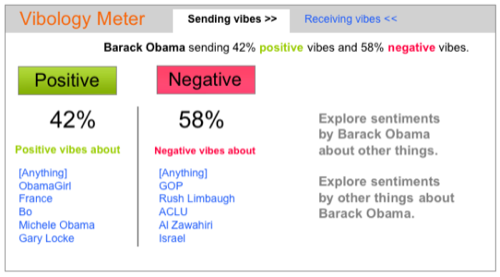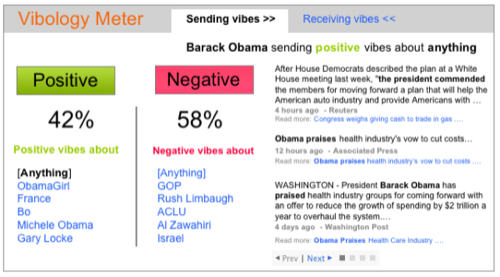Semantic search engine Evri can now understand how the web feels with the launch of their new sentiment web API. While busy scouring the net for people, places, and things and determining the relationships between them, the search engine is now able to understand the feelings associated with these entities, too, be them positive or negative. Using the API, developers can build applications for things like market intelligence, market research, sports and entertainment, brand management, product reviews and more.

Not Just Good or Bad, but Who, What, and Why, Too
At first we thought Evri’s API would simply rank things as positive or negative, much like the Twitter tracker twendz does today, highlighting positive, negative, and neutral items. However, the sentiment API does so much more, allowing you deeper insight into the “who’s,” and “what’s,” and “why’s” associated with the particular expression or feeling.
To be more specific, according to the announcement, Evri lets you:
- Find the percentage of positive and negative expressions of sentiment made by an entity, or about an entity. For example, find out what percentage of things being written about the iPhone are positive and which percent are negative.
- Discover who is criticizing and who is praising a particular person, place or thing. For example, see who is criticizing and praising Microsoft right now.
- Read whatpraisers and critics are saying about an entity. For example, see what the GOP are saying about the Democrats.
- Discover who or what your favorite entity is bashing and why. For example, see who Lance Armstrong is complaining about.
- Discover who or what your favorite entity is praising and why. For example, see who the World Health Organization is commending and why.
When unleashed upon the web as a whole, this could unearth a veritable goldmine of information. Just thinking of how many different ways it could be used is enough to blow anyone’s mind. Of course, marketers will be the first to jump on board, looking for practical ways to track the feelings about their companies, clients, and brands and why they’re changing, but an engine that understands sentiment could do so much more than just this. It can literally take the pulse of the web the way we take the pulse of Twitter using apps like the above-mentioned twendz to rank trends as positive or negative.
Demo: The “Vibology Meter”
To demonstrate what Evri can do, the company created a widget called the “Vibology Meter.” (Sadly, no link is provided). The widget not only ranks the good or bad “vibes” about a particular entity (in the example, Barack Obama), but also explores topics associated with that entity and whether or not the primary entity feels positively or negatively towards them. For example, the widget shows Obama is negative towards the GOP and Rush Limbaugh but feels positive about Michele Obama. (Well, that’s good!)

When you click on any one of the associated topics (or click on “anything” to see all topics of either positive or negative slant), you’re then presented with a sidebar of information. Here, snippets from articles found on the web display along with a title, link, and timestamp.

Of course, this is just a simple example of the Evri API in action. We’re sure the developers out there can think up even better ideas than this.
Challenges Ahead
The challenge now for Evri is to keep expanding its index in order to track more sources to rank. At the moment, the engine doesn’t track a large slice of the web the way a typical search engine like Google does – in fact they don’t even claim to be a search engine…despite what that “Go to” box on their homepage would have you believe. Instead, Evri looks specifically at the people, places, and things on the web and maps the connections between them.
To determine these connections – and now, the associated sentiments as well – Evri pulls from a limited number of “highly regarded” sources. That means you’ll definitely see a site like CNN used to rank a person like Obama, but the myriad of tiny politico blogs will be ignored. That’s actually a shame, since delving into this “long tail” of the web could give a better overall picture of how all people really feel, not just the sentiments expressed on high-profile sites written by top bloggers and journalists. Still, we know indexing and parsing this long tail is something that’s much easier said than done.
In the end, what Evri’s doing, even on this smaller scale, is definitely interesting. We hope to see the new API put to good use in the near future.





















